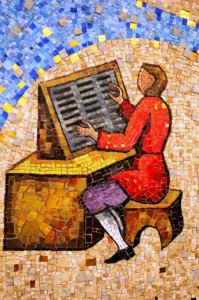All the news that fits: The view from where I sit
12 February 2014 – Cathy Stanton

Typesetter, John A. Prior Health Services Library mosaic mural, Columbus, Ohio. Photo credit: Ehschnell at en.wikipedia.
For quite a number of years now, I’ve been one of the people involved in gathering and disseminating news about the public history field through the various channels of the National Council on Public History: the H-Public listserv, the News Feed here in the Public History Commons, and the regular emailed updates that go out to NCPH members. More or less once a week, I cull through other listservs, submitted announcements, and odds and ends that come to us through various professional and social networks and try to reduce the pile to a more or less digestible-sized list of professional opportunities for public historians. Sometimes this feels like a purely clerical task (there’s a lot of cutting and pasting involved!) but every once in a while I realize what a valuable and broad perspective it’s given me on our ever-evolving field. In return for those hours of cutting and pasting, I get an ongoing education about what people are doing “out there” and how a very wide range of practitioners are putting history to work in the world. Here’s how things look to me at the moment.
I see a lot of ongoing efforts at redefinition and professional development, in areas ranging from the purely technical (for example, conservation techniques for windows or iron) to the organizational (for example, volunteer recruitment). Fields that have been developing along parallel but not necessarily intersecting lines for some time seem to be moving into closer relationship–for example, German and Holocaust studies, women’s history and tourism/heritage studies, or library/archive work and memory studies. There’s a growing trend toward using history within reconciliation and civic dialogue projects, including those addressing racial injustice, urban space, and conflict resolution.
The digital realm is making a lot of this much more widely accessible, of course. But it also seems to me that we’re beginning to move beyond seeing the digital as a separate sphere and just taking it for granted as one aspect of many things that we do as public historians.
Making change within professional discourses and institutional directions is often slow, difficult work, and there have been times over my years of news gathering when I’ve felt that more collective effort was going into pure maintenance than into innovation. Lately, though, I think we’re seeing the payoff from a lot of widely dispersed efforts to build strong professional and intellectual networks, reach new audiences, and articulate the value of historical knowledge in public. Overall, I’m struck by the increasing liveliness and interdisciplinarity of a lot of what’s going on around the field.
For example, that workshop on restoring historic windows is linked with concerns about energy efficiency, while the conference on libraries and archives and public memories is posing tough questions about social justice and past repressions of memory at collecting institutions. Looking at the programs of conferences, workshops, symposia, and other professional gatherings, it strikes me that people around the field have gotten a lot savvier about creating engaging, publicly accessible, and intellectually cutting-edge events. Putting the news digest together often leads me to flights of fantasy: I want to run away to sea, hear Bobby Rush perform at Elvis Presley’s house, and delve into critical theory while exploring prehistoric architecture in Iceland. I’m often tickled by being part of a field that includes historians in the US federal government, British graduate students convening meetings on history in popular culture, indigenous storytellers, scholars and artists from around the Global North focusing on postindustrialism, oral historians from far too many places to list here, an international network of city museums, and so much more–and that’s just from the past handful of news listings.
Not everyone in this variegated field identifies as a public historian, of course. And over the years I’ve realized that I’m probably helping to create a sense of field as well as reflecting it. As someone trained during the “postmodern moment,” when knowledge came to be seen as an ongoing social construction, I’m okay with that. Maintaining a small node within all of these lively networks feels like a privilege and an opportunity to contribute to the larger professional and civic conversations we’re all part of. And for what it’s worth, from where I sit at the moment, I’m increasingly hopeful about public history’s capacity to contribute in meaningful ways to projects of rethinking and reinvention on many scales.
Now back to cutting and pasting…
~ Cathy Stanton is Digital Media Editor for the National Council on Public History.



